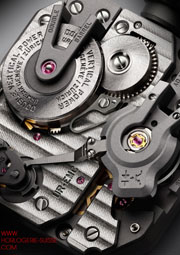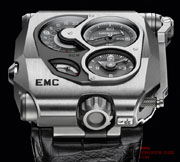

Urwerk
Nouveautés 2013 des montres Urwerk
Urwerk EMC
 Il y a tout juste 4 mois, durant le salon horloger de Baselworld, URWERK dévoilait l’un des concepts les plus ambitieux et révolutionnaires du moment : le premier mouvement mécanique « intelligent », l’EMC. Derrière ces quelques lettres se cachait déjà le concept de l’Electro Mechanical Control. La première montre de précision entièrement mécanique portant en son sein, un module d’évaluation de ses paramètres : « L’idée de l’EMC remonte à près de 6 ans déjà et découle directement de mon travail à l’établi » explique Felix Baumgartner, maître horloger et co-fondateur d’URWERK. « En effet, comme tout horloger, j’ai sur mon plan de travail un instrument de contrôle qui vient sanctionner mon ouvrage, un Witschi. C’est un juge impartial et intransigeant qui «écoute» le rythme du balancier et rend son verdict quant à la performance du mouvement. C’est ma référence et mon seul boss à l’atelier ».
Il y a tout juste 4 mois, durant le salon horloger de Baselworld, URWERK dévoilait l’un des concepts les plus ambitieux et révolutionnaires du moment : le premier mouvement mécanique « intelligent », l’EMC. Derrière ces quelques lettres se cachait déjà le concept de l’Electro Mechanical Control. La première montre de précision entièrement mécanique portant en son sein, un module d’évaluation de ses paramètres : « L’idée de l’EMC remonte à près de 6 ans déjà et découle directement de mon travail à l’établi » explique Felix Baumgartner, maître horloger et co-fondateur d’URWERK. « En effet, comme tout horloger, j’ai sur mon plan de travail un instrument de contrôle qui vient sanctionner mon ouvrage, un Witschi. C’est un juge impartial et intransigeant qui «écoute» le rythme du balancier et rend son verdict quant à la performance du mouvement. C’est ma référence et mon seul boss à l’atelier ».
L’idée folle d’intégrer un tel instrument de mesure, « un cerveau », dans une montre à 100% mécanique s’est imposée comme un défi ultime pour URWERK. « Sur simple pression d’un bouton, vous aurez une donnée sûre et précise sur votre EMC. C’est une information qui jusqu’alors n’était accessible qu’à un professionnel. Grâce à celle-ci, vous pourrez intervenir sur un des mécanismes les plus excitants et les plus jubilatoires inventés par l’homme, la montre mécanique, et ce en toute sécurité » poursuit-il.
Le principe de l’EMC s’est ainsi imposé avec un triple objectifs : montrer l’influence des paramètres extérieurs (activité, chaleur, pression) sur le mécanisme balancier-spiral ; corriger ces distorsions à la source ; permettre un échange, encourager l’interactivité entre une montre et son possesseur.
L’EMC prend l’apparence d’un control board avec ses quatre cadrans distincts. L’emphase est portée sur le cadran de la seconde (cadran positionné à 2h). C’est un des éléments phare de l’EMC, l’étalon de sa bonne marche et de son exactitude. A sa gauche – à 10 h – l’affichage de la performance de l’EMC exprimée en seconde par jour. En dessous – à 7h – la réserve de marche de l’EMC. L’indication classique des heures et minutes se fait à 5h – cette indication se fait par le biais d’un jeu d’aiguilles standard, une première pour URWERK.
Au dos de l’EMC, son mouvement maison est visible derrière une glace saphir.
Ce mouvement manufacture URWERK a été pensé, développé et usiné dans les ateliers d’URWERK.
 Son balancier a été réalisé en ARCAP, un alliage affectionné par URWERK pour ses propriétés non-magnétique et anticorrosive. L’originalité de ce balancier est remarquable au premier coup d’œil. Sa morphologie parfaitement linéaire a fait l’objet de calculs savants afin d’améliorer son aérodynamisme et minimiser les perturbations causées par la friction d’air. Ceci lui permet de garder une amplitude optimale.
Son balancier a été réalisé en ARCAP, un alliage affectionné par URWERK pour ses propriétés non-magnétique et anticorrosive. L’originalité de ce balancier est remarquable au premier coup d’œil. Sa morphologie parfaitement linéaire a fait l’objet de calculs savants afin d’améliorer son aérodynamisme et minimiser les perturbations causées par la friction d’air. Ceci lui permet de garder une amplitude optimale.- Son organe moteur a pris la forme d’un imposant double barillets monté en vertical sur un même axe. Ce double barillets monté en série assure la stabilité et la performance linéaire de l’EMC. Ils permettent à l’EMC d’afficher 80 heures de réserve de marche.
- Sa vis de régulation accessible depuis l’extérieur de la montre permet un ajustement précis par la raquette, en modifiant la longueur active du spiral.
Le « cerveau » de l’EMC est ainsi composé :
- D’un capteur optique en lien avec le balancier (Optical sensor). Ce capteur est composé d’un émetteur et d’un récepteur positionné de part et d’autre du balancier. Son rôle est d’enregistrer les oscillations de cet organe de 28'800 a/h, soit 4hertz, sur un laps de temps de 3 secondes. Cette mesure est déclenchée manuellement par pression d’un bouton poussoir (start button). - D’un oscillateur électronique à 16'000'000hz C’est l’élément de référence de l’EMC. La performance du balancier de l’EMC (4hz) est comparée à cet oscillateur hors norme afin d’obtenir la mesure la plus précise possible.
- D’une intelligence artificielle (computer) Ce calculateur est capable de déterminer le différentiel (symbolisé par la lettre δ) entre la marche du mouvement et l’oscillateur de référence. Chaque micro seconde de différence entre les deux parties est exprimée en gain ou perte d’une seconde par jour du mouvement mécanique. Ainsi une variation de 0.0000014s par demi-alternance se traduit par une variation d’une seconde par jour.
- D’un générateur à remontage manuel (generator) : L’organe de surveillance de l’EMC (le capteur optique et le calculateur) est alimenté en énergie grâce à un micro-rotor de l’entreprise suisse Maxon, célèbre pour avoir développé pour la Nasa et sa mission d’exploration sur Mars, le moteur du module Pathfinder.
 With EMC, not only can the wearer obtain the precise timing rate on demand, they can then use that information to accurately adjust the timing of their watch to suit their own personal rhythm. Electro Mechanical Control (EMC) is the world's first precision mechanical watch in which the timing can be monitored and adjusted by the user to suit their lifestyle – EMC is fully interactive.
With EMC, not only can the wearer obtain the precise timing rate on demand, they can then use that information to accurately adjust the timing of their watch to suit their own personal rhythm. Electro Mechanical Control (EMC) is the world's first precision mechanical watch in which the timing can be monitored and adjusted by the user to suit their lifestyle – EMC is fully interactive.
Please note that EMC is a fully 100% mechanical watch. The electronics have absolutely no effect on the movement; they only enable monitoring of the movement's precision in a similar way that the electronic speedometer or rev counter of a car has no effect on the mechanical engine and gearbox.
EMC features a deconstructed dial with four separate indications: A clockwise tour of the displays, from top left, presents the: on demand, precision indicator (instantaneous rate delta δ) ranging from -20 to + 20 seconds per day; seconds dial with counter-balanced seconds hand; hours and minutes; and 80-hour power reserve indicator. Turning EMC over reveals the fully in-house movement with the integrated circuit board – the EMC 'brain' –, the top of one of the two mainspring barrels near the crown and the top of the balance wheel and optical sensor on the winding handle side.
“Our idea for EMC goes back almost six years and is a natural continuation of my work as a watchmaker," says Felix Baumgartner, co-founder of URWERK. “Like all watchmakers, I have on my bench a Witschi – an instrument to test the precision of my work. This impartial and uncompromising judge ‘listens’ to the rhythm of the balance and makes a verdict on the performance of the movement by measuring the timing rate, the number of seconds the movement gains or loses in 24 hours. This device is what I always refer back to; you might say it’s my only boss in the atelier!”
The audacious idea to incorporate a Witschi-like measuring instrument in a mechanical watch became a veritable quest for URWERK. “EMC allows you to obtain a reliable and accurate piece of data on your timepiece at the touch of a button – information that until now has been the preserve of professional watchmakers,” says Baumgartner. “Using this information, you can fine-tune one of the most exciting, most jubilant mechanisms invented – the mechanical watch – all by yourself.” At its heart, EMC has a triple objective: to show how external parameters (positional changes, temperature and pressure) influence the timing of the movement; to enable the wearer to adjust the timing; and to facilitate interactivity between the timepiece and its owner.
EMC is inherently a precision mechanical watch with an in-house movement conceived, developed and crafted in the URWERK ateliers in Zurich and calibrated by URWERK in Geneva.
EMC movement is equipped with the following features:
 A bespoke balance wheel made of ARCAP, an alloy long admired by URWERK for its non-magnetic and anti-corrosion properties. From the very first glance, the originality of this specially-developed balance is striking. Its perfectly linear morphology is the result of careful calculations to optimise data from the optical sensor, maximise aerodynamic efficiency and minimise loss of amplitude.
A bespoke balance wheel made of ARCAP, an alloy long admired by URWERK for its non-magnetic and anti-corrosion properties. From the very first glance, the originality of this specially-developed balance is striking. Its perfectly linear morphology is the result of careful calculations to optimise data from the optical sensor, maximise aerodynamic efficiency and minimise loss of amplitude.- Power is provided by two large mainspring barrels in series, mounted vertically on a single shaft. These provide a long 80-hour power reserve, which is conducive to stable linear timing performance.
- The timing adjustment screw is accessible on the back of the watch and allows the owner to make very fine adjustments to the balance rate regulator by changing the active length of the balance.
The innovative EMC timing rate monitoring unit has been developed to include the following:
- An optical sensor on the balance wheel capturing the precise rate of oscillation of the 4 hertz / 28,800 vph regulator, over a period of 3 seconds. This sensor consists of a transmitter and a receiver positioned either side of the balance, and is triggered manually by pressing a button on the left side of the case.
- A 16,000,000-hertz electronic oscillator This provides EMC’s reference timing rate. The performance of the balance of EMC (4hz) is compared against this lightning-fast oscillator to obtain the most accurate measurement possible. - Artificial intelligence (the computer) This computer determines the difference between the timing rate of the movement and that of the reference oscillator. Each microsecond difference between the two values is expressed as a gain or loss of a second per day of the timing rate. A variation of just 0.0000014 of a second per half-vibration translates as a variation of a second per day.
- Manual-winding generator (the generator): EMC’s monitoring unit (the optical sensor and the computer) is powered by a micro-generator made by the Swiss company Maxon, which is well known for developing motors for NASA’s Mars rovers.
Eric Cosandey
©
toute reproduction strictement interdite
Tweet
On en parle sur le forum
La page de la marque